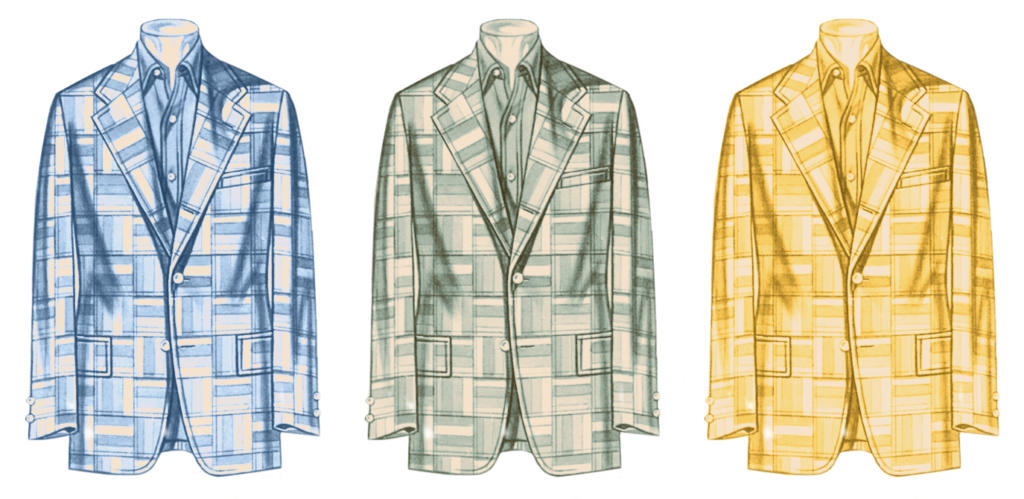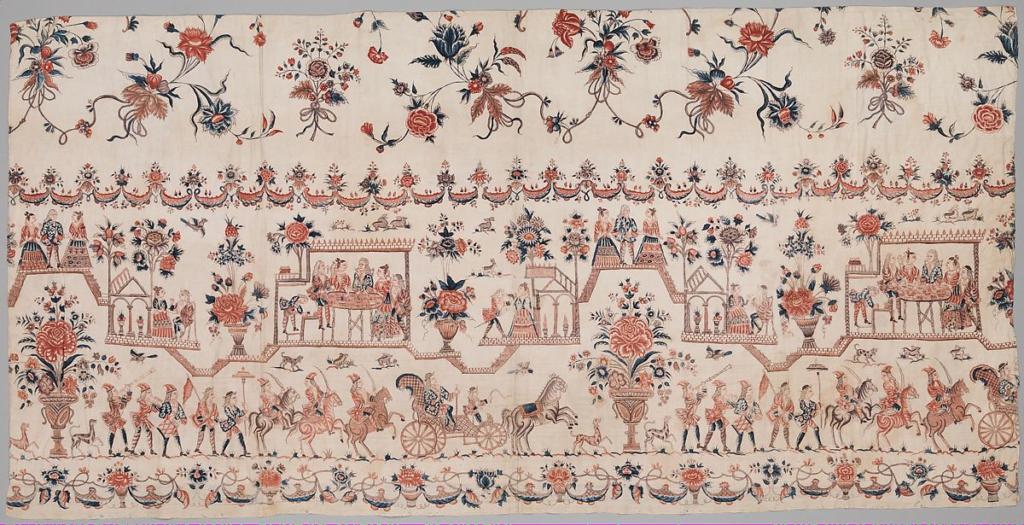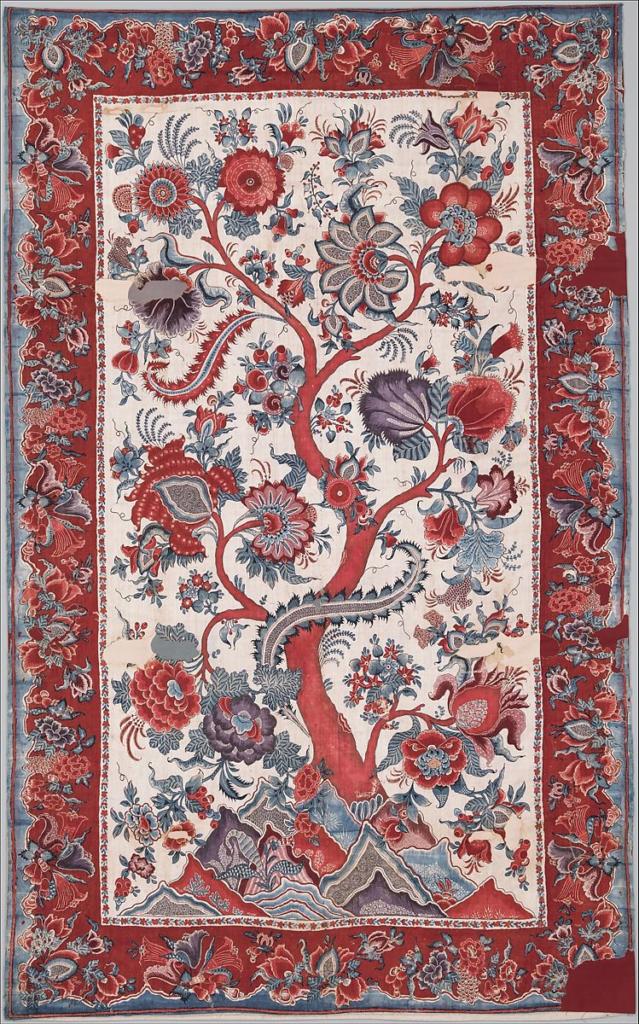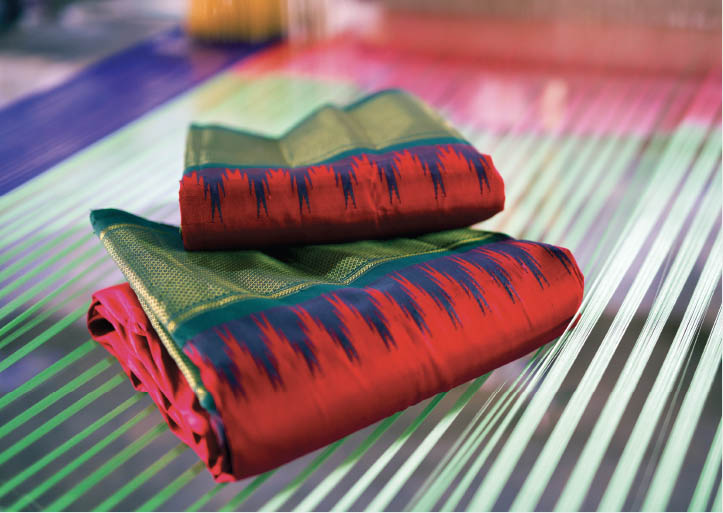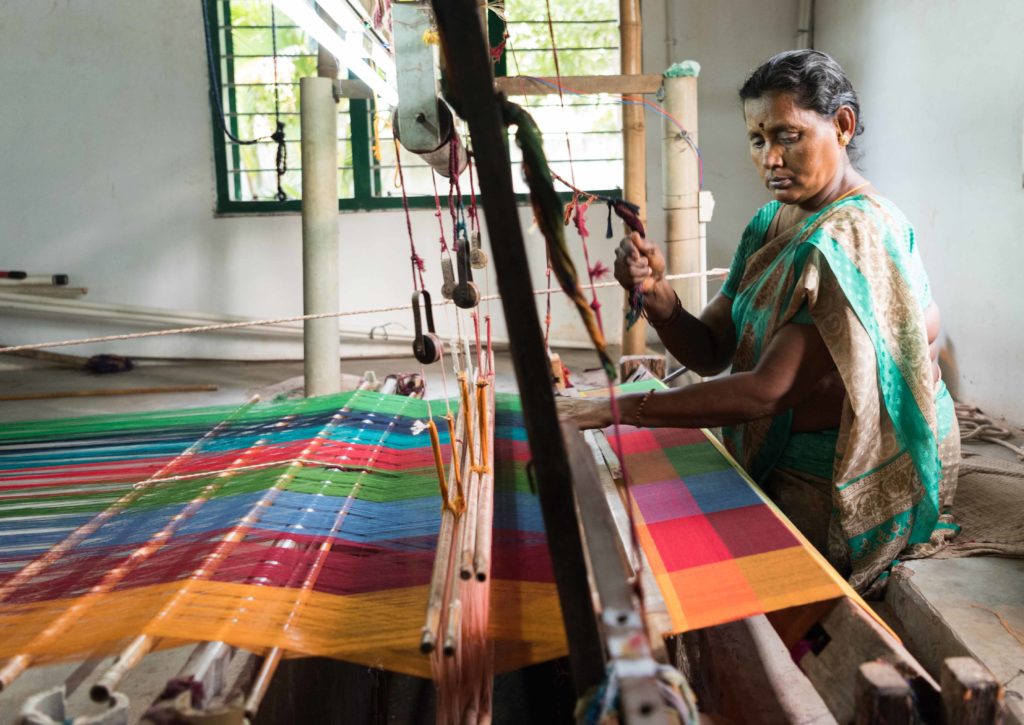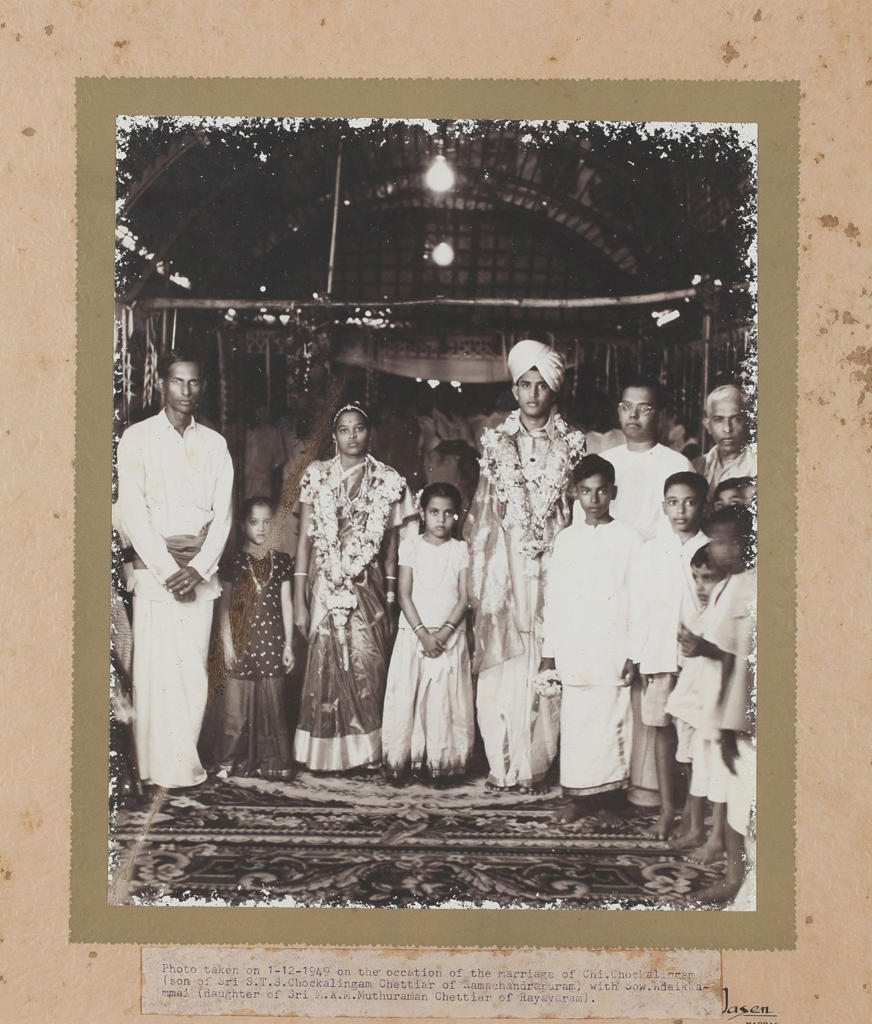
Wedding photograph of Chi.Chockalingam and Sow. Adaikkammai, R Dasen Studio © Sarmaya Arts Foundation
Southern India’s textile tradition dates to the Sangama period (1st century BCE to 6th century CE). Apart from spices and gemstones, it was finely crafted cloth that enriched the coffers of its kingdoms. Both native and foreign empires profited from the trade of textiles. But the difference lay in patronage. Many regional dynasties patronised communities of weavers or artisans for generations, in the process creating sustainable ecosystems for the craft and cultural legacies for themselves. Colonial entities, in comparison, didn’t enter with a view to investing quite as much money or time in the enterprise—their interest was more straightforwardly commercial. And yet, they too left an indelible impact on the textile traditions that they mined so profitably. When the British established the Madras Presidency on a non-descript strip of the Coromandel Coast in 1639, they could not have imagined the ways in which this new trading port would come to define their own place in the world. Of fashion, among other things.
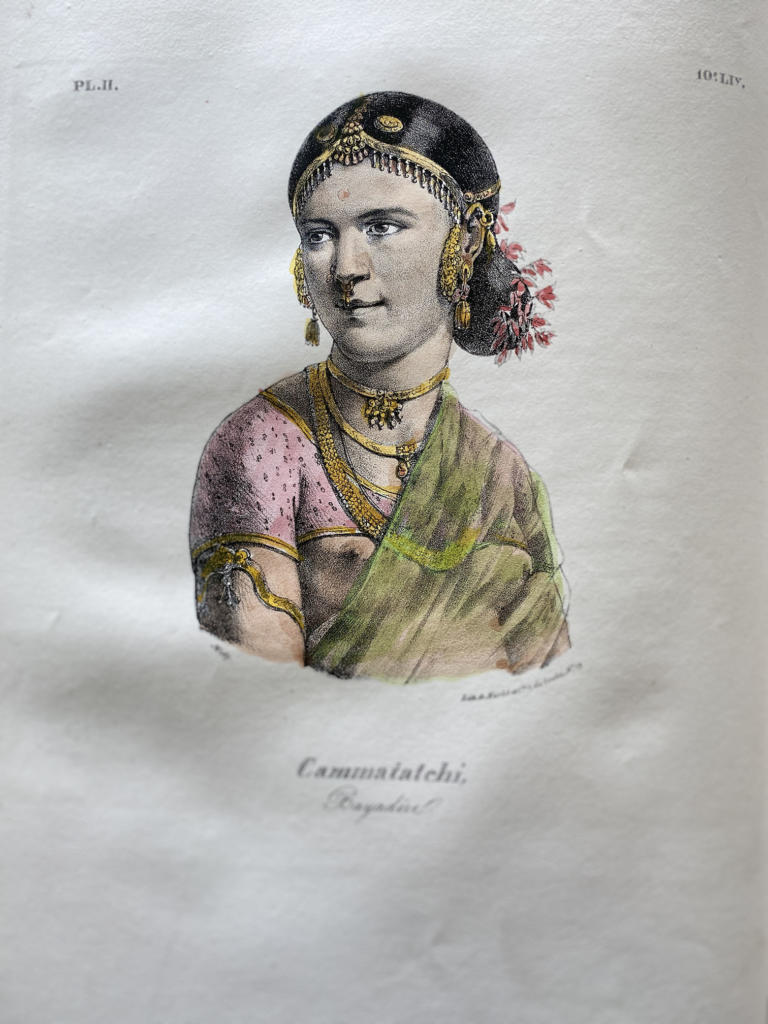
From L’Inde Francaise, rare book containing hand-coloured lithographed plates, 1827-1835 © Sarmaya Arts Foundation
By the 17th Century, textiles dominated the mix of goods traded along the Coromandel Coast. One of the reasons for this was the migration, over the centuries, of weavers from Saurashtra who settled in parts of present-day Tamil Nadu (some even speak a hybrid language called Sourashtram). They would set up weaving hubs near rivers since the textiles need to be bleached. The rich alluvial soil or vandal mannu deposited along the Cheyyar River that runs through the Tiruvannamalai district was considered most suitable for processing cloth. As a result, the weavers were concentrated there as well as in towns like Maduranthakam, Chengalpattu and Kanchipuram.
It was the Dutch who first discovered the demand for Indian textiles in Southeast Asia, leading to the founding of the Dutch East India Company. But the British quickly followed in their footsteps and, with the establishing and consolidating of the Madras Presidency during the 17th and 18th centuries, eventually edged out all other foreign competition from the region. Then began a process of rapid growth.
During the 19th Century, handloom censuses were taken several times in the Presidency. According to one, 2,80,000 looms were in operation in the Presidency in 1871. Four districts, namely, Madras, Chengalpattu, North Arcot and Salem, housed more than 5,000 looms for every 1,000 square miles. The Company set up India’s first cotton spinning mill in Rajahmundry in 1870 and eventually, Coimbatore came to be known as the Manchester of India for the sheer number of cotton ginning and spinning units in the city.
While it is safe to say that almost none of these textiles truly flourished during the British rule, the cultural exchange that trade allowed informed their evolution. The Madras Presidency also played an important role in documenting some ancient techniques. Some of these textiles not only acquired international repute but also went on to cement their position on the global fashion stage, while others faded into oblivion.
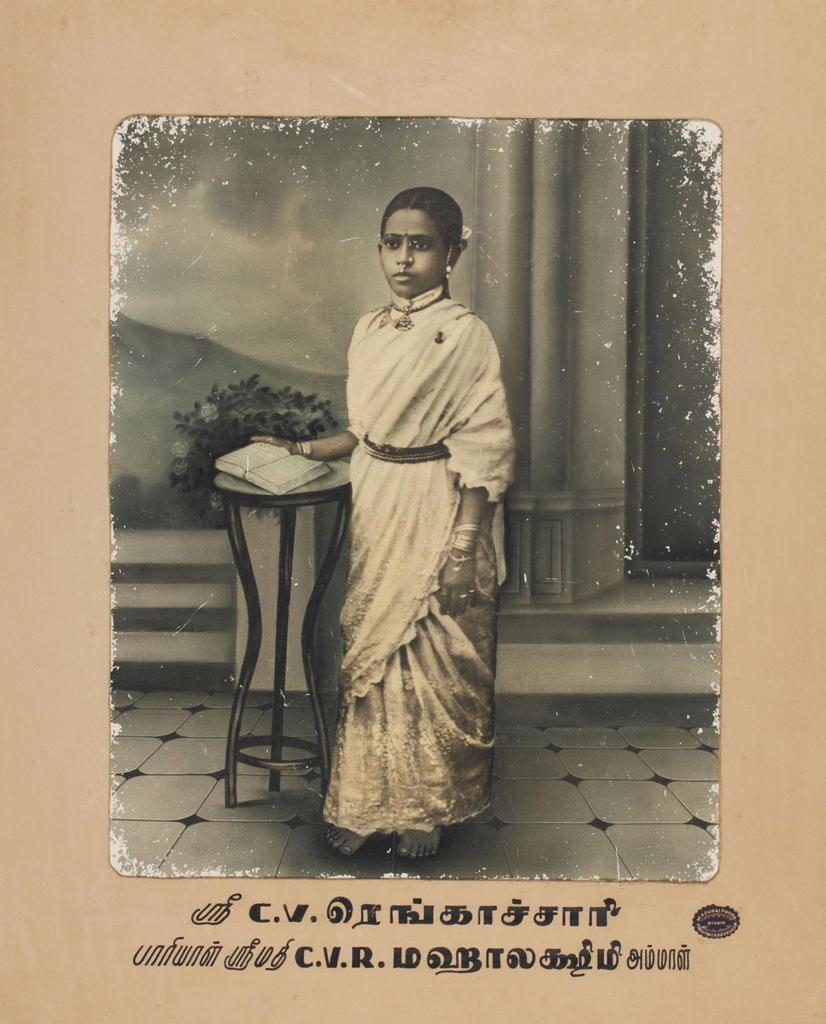
Brahmasri Kutte L. Ramachandrayyae Pariyal Srimathi Seshammal, Madhura Photo Studio © Sarmaya Arts Foundation
Colonial influence also extended to local dress and jewellery, which evolved within a complex matrix of class, caste and gender. The freedom movement later contributed to sartorial moments of historic and symbolic importance. For instance, it was on a visit to Madurai in 1921, that MK Gandhi first took to wearing the loincloth that would then become his trademark.
Madras checks
This legendary pattern traces its humble origins to Madraspatnam, where in the 12th century a lightweight, handwoven cotton fabric with a plaid, striped or checkered print was worn by local peasants. The checks, known as kattam, were originally woven in red, blue and white vegetable-dyed yarns and then washed. With each wash, the colours would smudge and bleed, creating a faded effect for which the textile eventually came to be known and loved.
Madras-checked cloth was sent out by exporters from Madras during the 1800s, along with the Real Madras Handkerchief made in Chirala, Andhra Pradesh and yarn-dyed handwoven cotton lungis made in Cuddalore. These began to be included under the larger umbrella of textiles known simply as ‘Madras’. The Real Madras Handkerchief was exported to Nigeria and it soon became an ethnic marker of the West African tribal women who used the checkered eight-yard piece as a sarong or wrapper worn around the hips and as head ties. The Madras handkerchief was given the prefix ‘real’ as many imitations of it were being produced across the globe.
The popularity of Madras reached its peak in the 1950s when it was adopted by Americans who associated it with the preppy, elite Ivy style and began to be included in the offerings of retailers such as Brooks Brothers, LL Bean, and Ralph Lauren. Madras was produced on pit looms with the weaver seated at the edge of a pit dug into the floor working the treadles underneath with his feet. With the boom in demand for Madras, Swiss exporter DB Fröhlichdeveloped a mechanism to retrofit existing looms to a 45-inch-width making it possible for the cloth to be incorporated into 20th-Century industrial manufacturing systems.
Coromandel chintz
The earliest reference to Coromandel chintz was made in 1663 by French physician and traveller François Bernier in his description of Emperor Shah Jahan’s reception tent. “It was lined with those chittis, or cloths painted by a pencil of Masulipitam, purposely wrought and contrived with such vivid colours and flowers, so naturally drawn, of a hundred several fashions and shapes, that one would have said it was a hanging parterre,” he wrote.
Later WS Hadaway, American artist and superintendent at the School of Arts in Madras, attempted to document details of this art in an instructional text titled Cotton Painting and Printing in the Madras Presidency. In it, he described Coromandel chintz as a mix of intricate pen work/ illustration, stencil and block printing practised across Madurai, Paramagudi, Kumbakonam, Negapatam, Chengalpattu, Tirunelveli, Wallajah and Masulipatnam. He also detailed the process of how the coarse cotton cloth was treated with chunam (lime) and printed with natural dyes, including indigo obtained from the seeds of the thagarai plant and Bengal madder for red.
As early as 1676, a French refugee established a cotton printing plant at Richmond, and almost all the early patterns used by European printers were adaptations of the Coromandel chintz. In 1721, the British Parliament passed the Calico Act prohibiting the use of Indian calicos in England to protect the interests of English manufacturers. The handmade Coromandel chintz found it hard to fight the European machine-made imitations, which led to a considerable tapering off of demand.
Originating in the town of Kanchipuram, 72 kms from Madras in the Chingleput district in the Madras Presidency, Kanjeevaram silk weaving was characterised by the use of mulberry silk with gold and silver zari threads. Rajaraja Chola I invited weavers from Saurashtra to settle down and set up their looms in the town of Kanchipuram: they came to be known as pattunulkarars or silk weavers.
Kanjeevaram saris are known for the getti pattu or heavy silk used, and they were originally woven only in about 15 colour combinations. The weavers compared the sheen of the saree to the sparkling waters of the Palar river that flows through the city. The large-scale industrialisation of Kanchipuram silks happened under the reign of Krishna Devaraya of the Vijayanagara empire. Kanjeevaram saris get their name from Congeevaram, the old British name for the town of Kanchipuram. During the infamous Carnatic Wars fought between the English and the French in the 18th century, the city was burned down, bringing the silk weaving industry to the brink of extinction. But it managed to resurrect itself and went on to become one of the most prized forms of silk weaving in the world.
Kandangi, Sungudi and Korvai weaves
In the 17th Century, Madurai came to be known for its tie-dye Sungudi saris handmade by the skilled Saurashtrian weavers settled in the region. Sungudi comes from the word sunnam, which refers to the nought or zero pattern achieved through the bandhani-like tie-and-dye process. The textile art flourished under the patronage of King Thirumalai Naicker of the Nayaka dynasty.
The scarcely documented Kandangi sari, among the state’s oldest weaves (almost 250 years old), was introduced and patronised by the wealthy Nagarathar community of Chettinad. Characterised by their striking colour combinations, tall borders and the use of bold stripes and checks, these saris were strong enough to last generations. “Nothing ever tore and that’s the whole story,” textile revivalist Visalakshi Ramaswamy told us about the legendary Kandangi saris.
Native to Thanjavur are the stunning Korvai silks, made into saris, dhotis etc and woven using an ancient labour-intensive technique that requires two weavers to handle the shuttles at the loom. Korvai designs drew inspiration from the grand temple gateways or gopurams for their borders.
From 1750 onwards, Madras Presidency’s local handloom textiles began to decline. In 1928, the Royal Commission on Agriculture recommended that “for the survival of village industries in fast increasing competitions, it is essential that they are developed on cooperative basis.” In 1935, an apex body for the welfare of weavers was formed for the first time in the country in Madras Presidency. Post independence, it was renamed the Tamil Nadu Handloom Weavers Cooperative Society which became Co-optex. Today, Co-optex is putting significant efforts into reviving these regional weaves and supporting over 1,100 cooperative societies and 2.5 lakh handloom weaving units in Tamil Nadu.
Madras Lace
Hand-made bobbin lace-making was brought to Kanyakumari by Christian missionaries from Belgium and England. The locals of Mulagumoodu village in present-day Kanyakumari adopted lacemaking as their own. There came a time when almost every household in the village had a woman making lace that was eventually exported to Germany, Rome and other parts of Europe.
The nuns associated with the Infant Jesus Teacher Training Institute, Mulagumoodu continued the art turning out beautiful napkins, curtains and children’s clothing made from lace. In the 19th Century, lacemaking began to spread from the Madras Presidency to other parts of British India, including Punjab and Calcutta.
In the mid-19th century, the British also set up a few lacemaking factories with Nottingham lace looms in the Madras Presidency to produce 100 per cent cotton lace. The weaving process for Madras lace is slow, taking a full day to produce twelve yards. This variety of pure cotton lace is produced in Scotland today and is highly-prized.
Drapes and stitches
The influence of western dress in the presidency resulted in a mixed aesthetic where upper-class Brahmin men wore a jibba or shirt with a veshti and angavastram and women wore the madisars or nine-yard saris, belted at the waist, with Victorian puff-sleeved blouses creating a European-inspired silhouette. Younger girls also wore puff-sleeved blouses with their langas or pavadais.
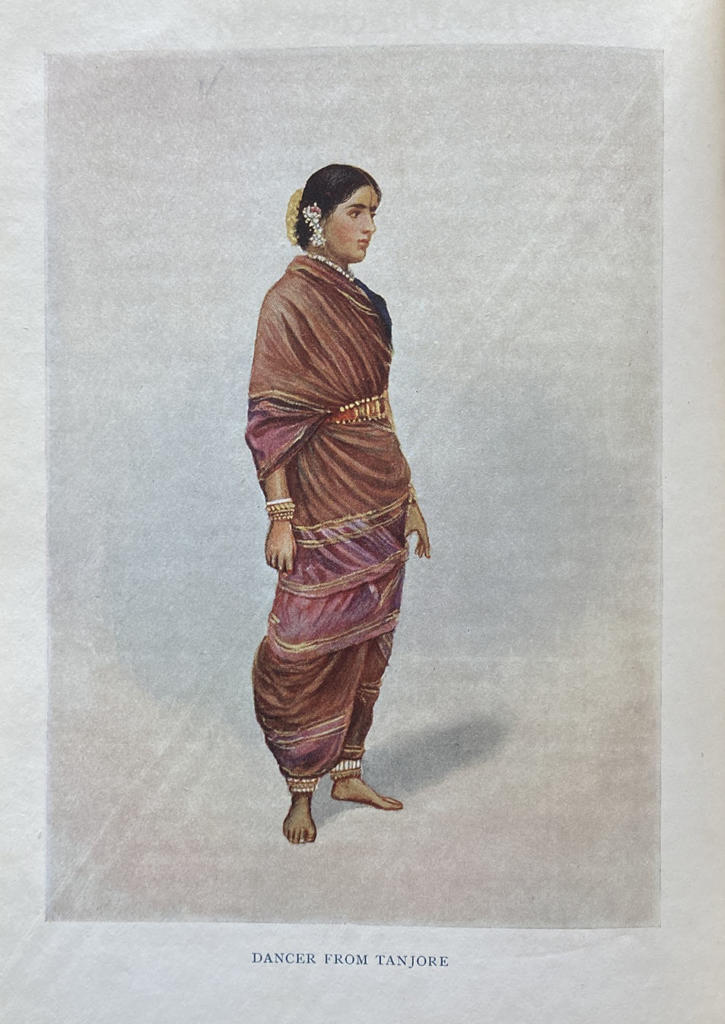
From ‘Women of India’ by Otto Rothfeld, painted by MV Dhurandhar, rare book, 1928 © Sarmaya Arts Foundation
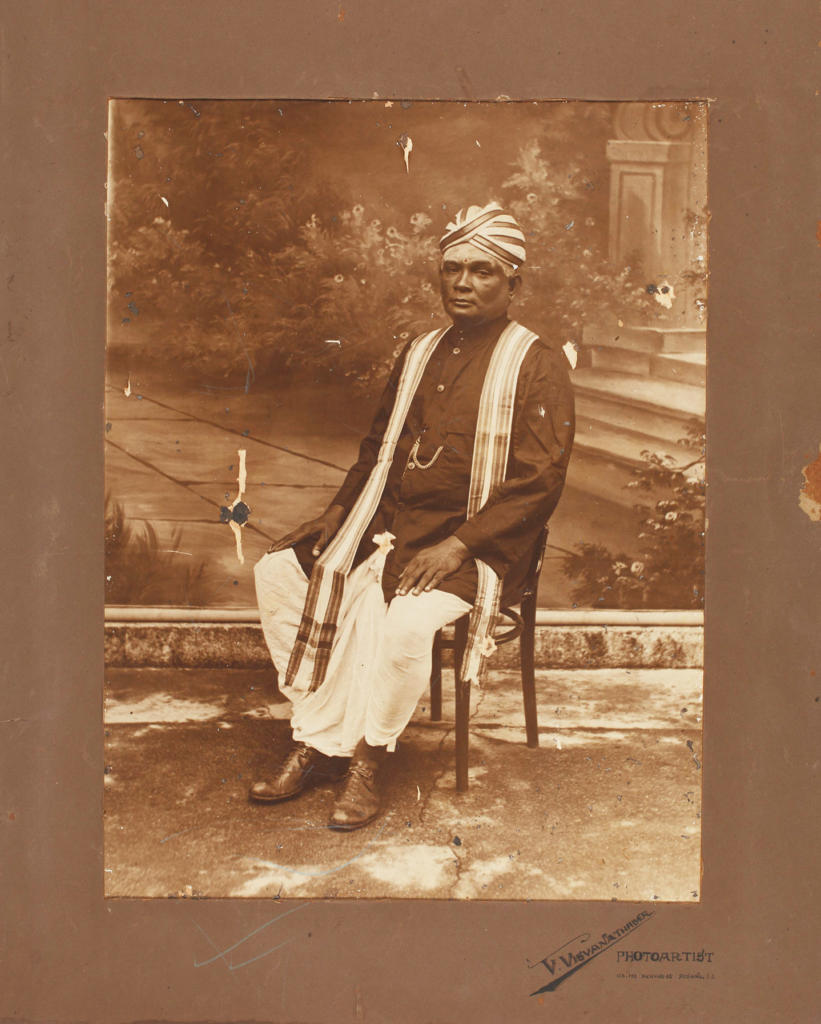
Sangeetha Sangathoni Raja. A. Kumarasami Nadaravargal Aruppukkotai, Karaikudi © Sarmaya Arts Foundation
The evolution of the sari across the country was influenced by Victorian Era ideals of modesty and propriety as the petticoat and blouse entered the Indian lexicon. Annie Besant springs to mind, in her cotton saris and Victorian blouses, walking in and out of the Theosophical Society’s offices in Adyar, Madras rallying up forces for India’s self-rule movement and eventually setting up the Home Rule League in 1916. The blouse quickly became a sign of dignity and respect, as only dominant-caste women were allowed to wear one.
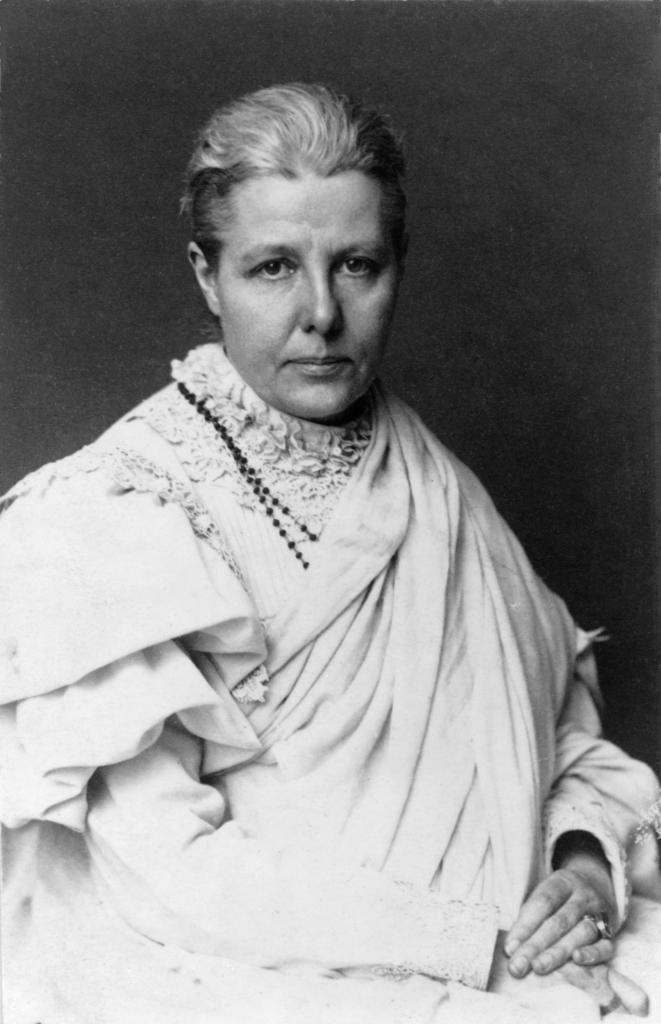
Annie Besant, image courtesy Wikipedia Creative Commons
Temple jewellery
The art of temple jewellery originated in the town of Vadaserry, in Nagercoil district, during the reign of the Chola and Pandya dynasties when royalty commissioned these pieces as part of the donations they made to temples. They were originally handcrafted in silver and finished with gold-leaf work. In the beginning, temple jewellery was reserved for the deities alone but eventually temple dancers and devotees started to get replicas made for themselves.
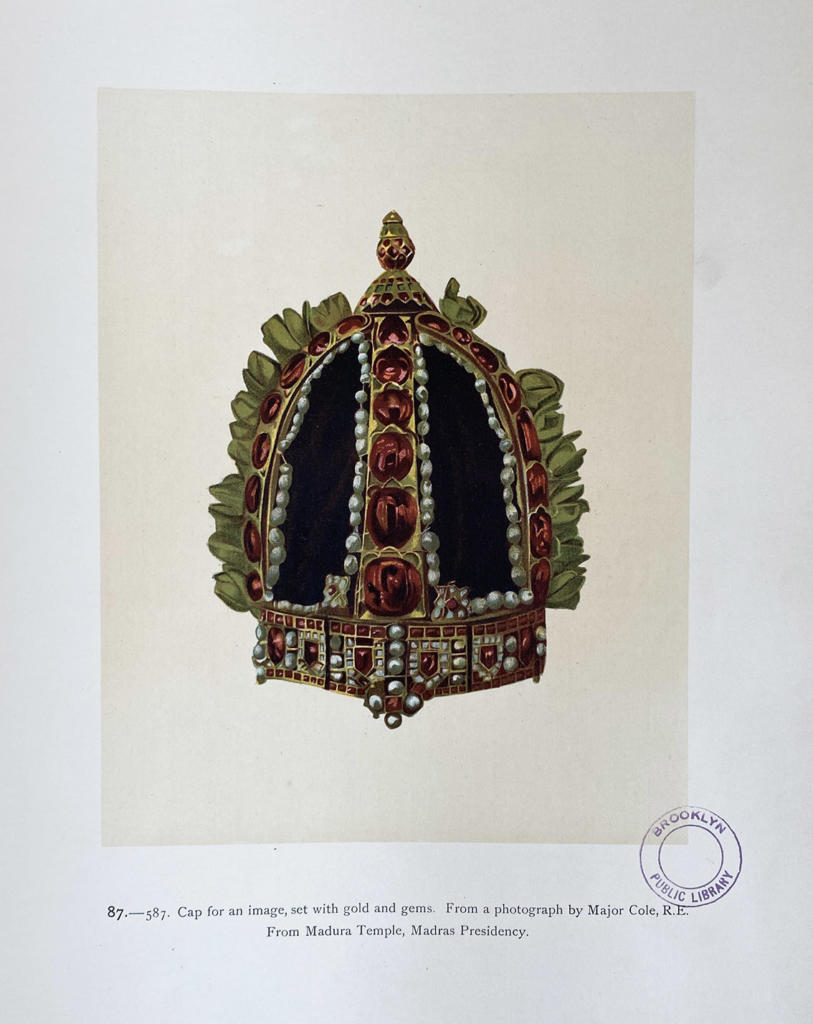
Crown from a temple in Madurai, rare book ‘Indian Jewellery’ by Thomas Holbein Hendley, 1906-1909 © Sarmaya Arts Foundation
Between 1857-58, British photographer Linnaeus Tripe was commissioned to make an extended photographic tour of the presidency’s districts and he produced six volumes of mostly temple photographs, which included details of the deities’ ornate crowns, forehead ornaments, stirrups of gold and bridles of pearls and coral.
Jewellers or acharis favoured motifs of the mythical creature yali, makara (crocodile), swans, parrots, serpents, mangos, lotuses and the deities themselves (Ganesha and the goddesses being most popular). Temple jewellery was characterised by the extensive use of pearls, rubies, emeralds, diamonds, which are set in place using a natural waxy gum called arraku. Ancient Tamil literature lists out the different types of jewellery to be worn by women from head to toe. These include the chutti on the forehead, surya and chandra pirais, and the rakkadi worn at the sides and back of the head respectively, kundalakesis or thodus and dangling jimikkis in the ears, mookuthis, besaris and bullakkus in the nose, vanki (armbands) and valays (bangles), chokers known as addigais, haarams and maalais around the neck, ornate oddiyanams around the waist and silambu or kolusu around the ankles.
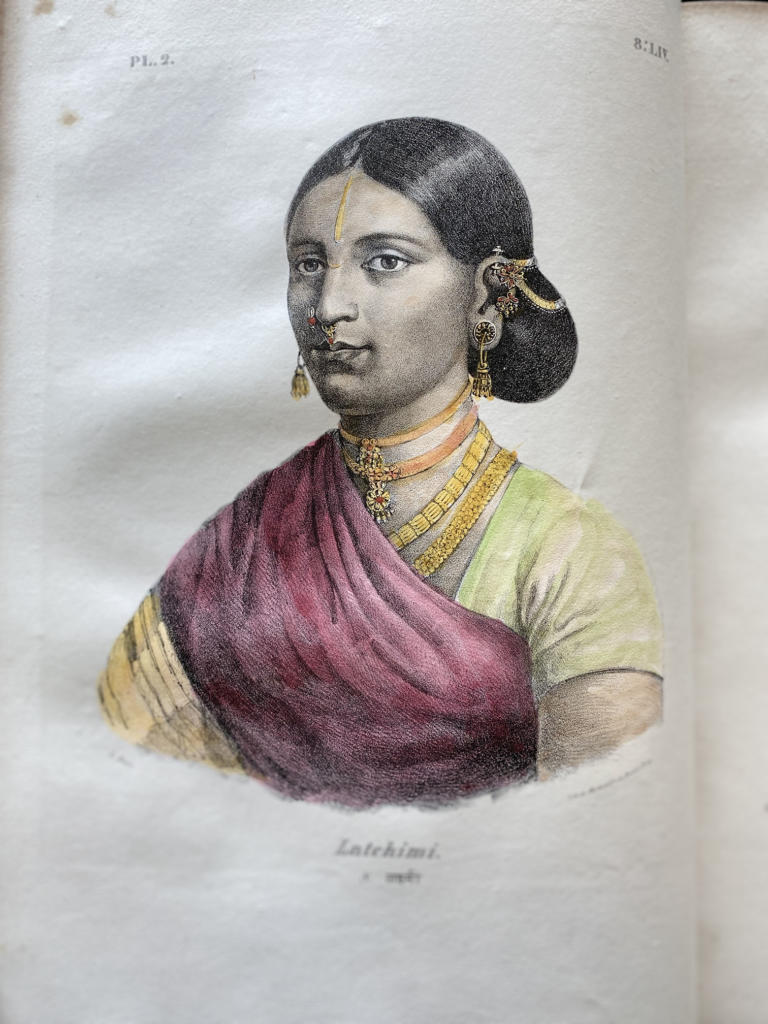
From the rare book L’Inde Francaise’ containing hand-coloured lithographed plates, 1827-1835 © Sarmaya Arts Foundation
Cross-cultural influences from Russia and Europe are believed to have impacted jewellery making in Madras Presidency. Indian princes and local chiefs bought jewellery from Cartier and Van Cleef & Arpels and British and European nobility began to request distinctively Indian jewellery, including hand-crafted temple jewels. Notably, one of Cartier’s most famous ‘tutti frutti’ style was said to be inspired partly by the flowers of South India.

